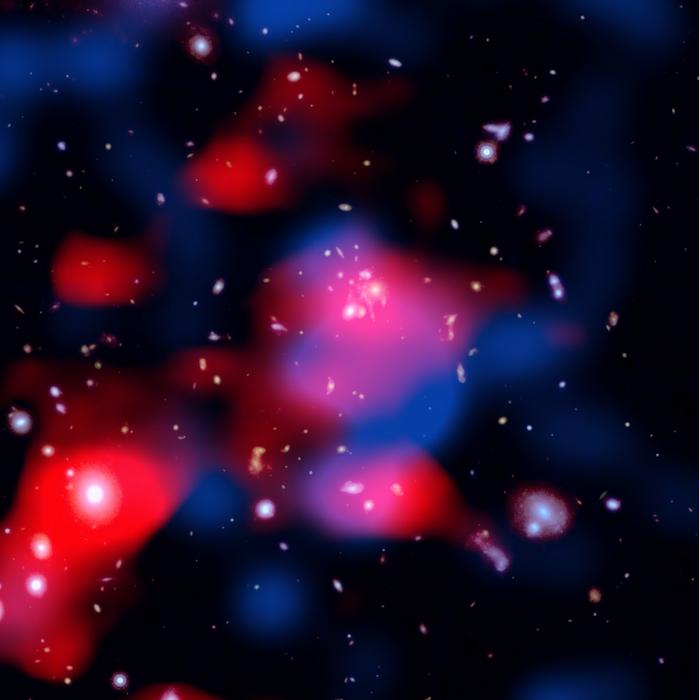Astronomers are making groundbreaking strides in our understanding of the universe, and a recent discovery has cast a new light on the cosmic phenomena within distant galaxy clusters. A team of international researchers has successfully detected a radio mini-halo surrounding an exceptionally distant galaxy cluster, providing vital insights into the energetic forces that have influenced the cosmos. This mini-halo, comprised of high-energy charged particles, presents an unprecedented opportunity to explore the universe’s most monumental structures at a stage in their evolution that was previously shrouded in mystery.
Located a staggering ten billion light-years away from Earth, this mini-halo represents the farthest detection of its kind, effectively doubling the previously known distance. The significance of this finding extends beyond mere numbers; it suggests that these colossal galaxy clusters were permeated with high-energy particles far earlier in the universe’s timeline than previously anticipated. This discovery fundamentally alters our understanding of the cosmic landscape, highlighting that the phenomenon of energetic processes may have been shaping these massive structures long before we had assumed.
The composition of this mini-halo consists of highly energetic particles that coexist within the vast vacuum between the galaxies of the cluster. When observing the signals emanating from such structures, scientists look for radio waves that are indicative of charged particles. The recent data, analyzed from the Low Frequency Array (LOFAR) radio telescope, unveiled a faint yet widespread radio signal. This was not traced to individual galaxies, but rather a pervasive region rich in high-energy particles and magnetic fields.
Notably, the galaxy cluster under examination, identified as SpARCS1049, revealed a diffuse glow that spans over a million light-years. This glow serves as a quintessential marker of a mini-halo, a structure previously observed only within our galactic neighborhood. The findings from this research present a cosmic revelation, enabling astronomers to envision the early universe through a new lens. Julie Hlavacek-Larrondo, a co-leader of the research team from Université de Montréal, likens the discovery to unearthing a vast ocean of energy within which galaxy clusters remain steeped.
In discussing the implications of the study, researcher Roland Timmerman from Durham University emphasized the astonishing nature of detecting such a robust radio signal from an object at this unprecedented distance. The implications of this finding contending that energetic particles and the processes that generate them have been influential in the shaping of galaxy clusters throughout nearly the entire cosmic history cannot be understated. They not only reveal the dynamism of the universe’s oldest structures but also challenge existing theories regarding the origins of these energetic processes.
The research team has proposed two primary mechanisms for the formation of the mini-halo. The first hypothesis suggests that supermassive black holes residing at the centers of galaxies could be responsible for releasing streams of high-energy particles. However, researchers are still investigating the possible pathways that allow these particles to escape, while maintaining their energy, and how these processes contribute to the expansive mini-halo. The second hypothesis involves cosmic particle collisions; in this scenario, charged particles within the hot plasma of galaxy clusters collide at speeds nearing that of light, resulting in the creation of newly energized particles observable from our vantage point.
The discovery of this mini-halo opens a rare portal into the conditions of early galaxy clusters, providing an unprecedented opportunity to study the origins of high-energy particles and their subsequent evolution. It emphasizes the idea that such clusters have been enriched with these energetic particles far earlier than previously understood, indicating a complex interplay of cosmic forces at play long before the formation of our own galaxy.
As technology evolves, the advent of telescopes like the Square Kilometer Array (SKA) promises to enhance our capacity for observing even fainter signals in the cosmos. This advancement will facilitate more in-depth investigations into the roles of magnetic fields, cosmic rays, and energetic processes that govern the large-scale structure of the universe. With continued exploration, astronomers are hopeful that greater clarity will be achieved regarding how these energetic phenomena contribute to the evolution and growth of galaxy clusters.
In summary, the implications of the discovery of this distant radio mini-halo extend well beyond its immediate detection, offering vital insights into the energetic processes that have influenced galaxy formation over Billions of years. With a newfound understanding that energetic particles have been a crucial component of galaxy clusters much earlier in the universe’s history, researchers anticipate that this discovery will shed light on the fundamental nature of cosmic evolution and the behaviors of clusters as they grow and interact.
As astronomers continue to unravel the mysteries that lie within distant reaches of our universe, they are not just piecing together the story of cosmic evolution, but are also redefining our comprehension of physics at a grand scale. The research underscores the importance of collaborative international efforts as they embark on these discoveries, allowing for a more comprehensive understanding of the high-energy universe of which we are a part. This monumental finding reaffirms our place in the cosmos, inviting us to marvel at the intricate web of energy, matter, and time that governs the very fabric of existence.
Subject of Research: Detection of a radio mini-halo surrounding a distant galaxy cluster
Article Title: A Radio Mini-Halo in a Massive Cool Core Cluster of Galaxies at z = 1.709
News Publication Date: [Date of Publication]
Web References: [URLs if applicable]
References: [Related literature or references if applicable]
Image Credits: Chandra X-ray Center (X-ray: NASA/CXC/SAO; Optical: NASA/ESA/STScI; Radio: ASTRON/LOFAR; Image Processing: NASA/CXC/SAO/N. Wolk)
Keywords
cosmic evolution, galaxy clusters, radio mini-halo, high-energy particles, supermassive black holes, cosmic processes, astrophysics, universe structure.




